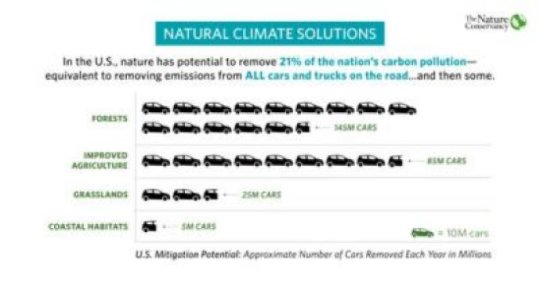[ad_1]
Restoring the United States’ lands and coastal wetlands could have a much bigger role in reducing global warming than previously thought, according to the most comprehensive national assessment to date of how greenhouse gas emissions can be reduced and stored in forests, farmland, grasslands, and wetlands.
The peer-reviewed study in Science Advances from The Nature Conservancy and 21 institutional partners found that nature’s contribution could equal 21% of the nation’s current net annual emissions, by adjusting 21 natural management practices to increase carbon storage and avoid greenhouse emissions. The study is the first to include the climate benefits of coastal wetlands and grasslands in a comprehensive mix along with forests and agriculture.
In October the Intergovernmental Panel on Climate Change special report called for global action immediately to limit warming to 1.5?Centigrade (approximately 3? Fahrenheit) to avoid the most damaging climate change impacts. This new study highlights how, and which, natural solutions in the United States offer the most promise to help limit temperatures below that 3? Fahrenheit goal.
Joe Fargione, Director of Science for The Nature Conservancy, was the study’s lead author: “One of America’s greatest assets is its land. Through changes in management, along with protecting and restoring natural lands, we demonstrated we could reduce carbon pollution and filter water, enhance fish and wildlife habitat, and have better soil health to grow our food — all at the same time. Nature offers us a simple, cost-effective way to help fight global warming. In combination with transitioning to zero carbon energy production, natural climate solutions can help protect our climate for future generations.”
Lynn Scarlett, Chief External Affairs Officer for The Nature Conservancy and former Deputy Secretary of the Department of the Interior, spoke to practical elements of the study’s findings: “An ounce of prevention is worth a pound of cure, so we should reduce carbon pollution where we can. But we also need to put natural solutions to work as a tool to insulate ourselves from global warming. This study provides good news that making investments in nature will make a big difference, while offering the potential for new revenue to farmers, ranchers, foresters, and coastal communities at the same time.”
Of the 21 natural solutions analyzed, increased reforestation (the planting of trees) emerged as the largest means to achieve greater carbon storage, equivalent to eliminating the emissions of 65 million passenger cars. Other high-performing forest solutions include allowing longer periods between timber harvest to increase carbon storage; increasing controlled burns and strategic thinning in forests to reduce the risk of megafire; and avoided loss of forests from urban sprawl.
The study identified a maximum of 156 million acres that could be reforested, 304 million acres where forest harvest rotations could be extended, and at least 42 million additional acres of forests that would benefit from fire risk reduction treatments. In addition, almost a million acres of forest are being converted to non-forest habitat a year, largely due to suburban and exurban expansion, which could be addressed through better land use planning. The study also finds that urban reforestation can add important carbon storage benefits.
“Planting trees and improving the health of existing forests will be a deciding factor in whether we are able to get ahead of the climate curve,” said Jad Daley, CEO of American Forests. “This breakthrough analysis clarifies the highest impact actions for keeping our forests as a growing and resilient carbon sink and the potential scale of climate benefit.”
Grasslands are underappreciated for their carbon storage opportunity. Grassland is being lost at a rate of over one million acres per year. When grassland is converted to cropland, about 28% of the carbon in the top meter of soil is released to the atmosphere. This trend could be reversed by re-enrolling 13 million acres of marginal cropland in conservation programs and restoring them to provide habitat and storage of carbon in the soil.
Existing croplands have an important role to play. Farmers can optimize their nutrient application, saving money and avoiding emissions of nitrous oxide, a potent greenhouse gas. Farmers can also plant cover crops, which suck carbon out the atmosphere and return it to the soil during times of the year when fields would normally be bare.
“Farmers are some of our best land stewards, and Danone North America is partnering with farms across the country to find climate solutions through our soil health initiative. Improved nutrient management, cover crops, and crop rotations are examples of practices that can help reduce GHG emissions and over time improve a farm’s bottom-line. Farmers and the food industry depend on a predictable climate, so it’s important to work together to reduce the risks of climate change.” said Chris Adamo, Vice President Federal & Industry Affairs at Danone North America.
Natural solutions can be found under water as well. An estimated 27% of tidal wetlands have been disconnected from the ocean, increasing the release of methane. Reconnecting tidal wetlands to the ocean virtually eliminates those methane emissions, and also restores fish habitat important for coastal communities.
“Shellfish growers make a living on the water and have witnessed salt marshes losing productivity due to freshwater inundation. Not only does this damage important waters and increase emissions, but it also harms their ability to make a living growing oysters, clams, mussels and other species that support many coastal communities and other important stakeholders. By restoring salt marshes, we can help shellfish farmers, wholesalers, retailers and restaurants and the climate all at the same time,” said Davis Herron, Director, Retail & Restaurant Division, Lobster Place, spokesman for the Shellfish Growers Climate Coalition.
Not only do natural climate solutions have strong benefits for personal enjoyment, healthier water, air, wildlife, and soil, many are quite affordable. As states and the federal government evaluate rules and markets for greenhouse gas emissions, these low-cost reductions from natural solutions offer the United States a powerful tool to address a warming planet.
[ad_2]















